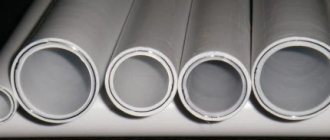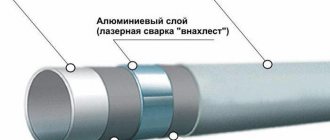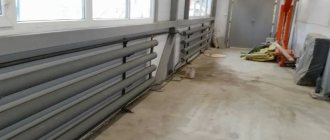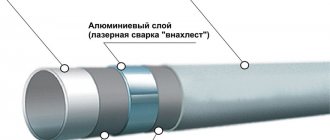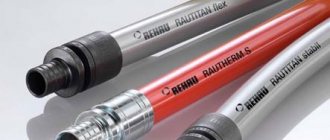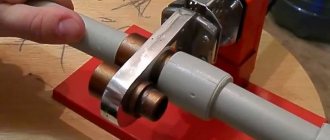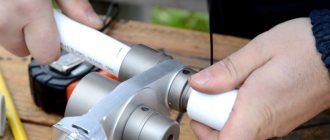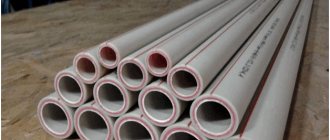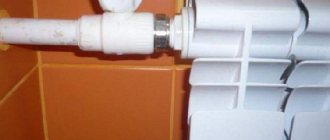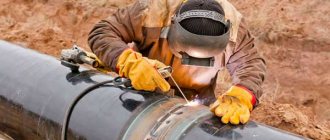Due to their high physical characteristics, metal-plastic pipelines have found wide application in various areas of household services. One of their main distinguishing features is that the installation of metal-plastic pipes is accessible to both specialists and ordinary users without special tools.
In order to lay a pipeline line with the help of hired workers, and even more so independently, it is useful to study the basic physical characteristics, as well as the dimensional parameters of plastic pipes. To install a metal-plastic pipeline, you should know the existing installation methods and the tools used for this.
Rice. 1 Pipes made of cross-linked PEX and heat-resistant PE-RT polyethylene - structure and appearance
List of tools required for work
Having made the calculations and purchased the required amount of material, you should stop at purchasing the most necessary tool. To install metal-plastic pipes, especially with your own hands, just pliers and a flat-head screwdriver will not be enough, so it’s better to spend a little money, but have everything you need at hand.
What you must buy:
- Pipe cutter The tool that should be purchased first. Using this device you can achieve smooth edges without any burrs or other damage.
High-quality and durable pipe cutter
- Press jaws. They belong to the category of crimping tools, using which you can connect two pipes by placing a press fitting on them.
- Calibrator. The calibrator is used for proper flaring, during which the surface of the metal-plastic product is not damaged.
Inexpensive calibrator
- Bevel remover. If the cut was made incorrectly or crookedly, then using a chamfer remover it can be given the correct shape.
- Set of open-end wrenches. For greater savings, you can purchase one adjustable wrench.
After collecting the necessary tools, you can proceed directly to the connection. But to do this, you should familiarize yourself with the methods of connecting or soldering metal-plastic pipes.
What is a compression fitting and how to use it
Compression fittings are often used not only by DIYers, but also by professional plumbers. So why are they so popular? The answer is simple: because of the mass of positive qualities and ease of installation.
Compression fitting
- To install a compression fitting, no specialized equipment is required; all you need to do is have an adjustable wrench on hand.
- Such products even tolerate burrs along the edge, so a pipe cutter may not be used here.
- There is no need to use a bevel remover or calibrator.
The installation sequence of the compression fitting is as follows:
- The nut, which has free play and is tightened after installation, is placed on the end of the product.
- The shank is wrapped several times with tow to make the connection more tight, and inserted into the product.
- A fixing nut is placed on the base of the fitting. Use one wrench to hold the body of the product, and the second to tighten the nut.
The simplicity of such installation can be deceptive and not many home craftsmen are able to make the correct connection the first time. When tightening the fixing nut, pay attention to the force applied, as the body of the compression fitting may crack.
Important! Before installing the product, be sure to check the presence of all O-rings, as well as fitting gaskets, which provide the required level of sealing. If they are absent, the connection will not be reliable and will require immediate replacement.
*
Properties and places of application of polypropylene
Two filters for cleaning. Self-washing and polypropylene thread
An important positive property of such a material is that corrosion processes have virtually no effect on the material. Low cost allows the use of polypropylene structures everywhere, and the ability to maintain tightness and integrity at a pressure of more than 20 bar makes it possible to use the material for water supply and heating in multi-story buildings. It is also worth noting the light weight and ease of installation. However, to solder homogeneous pipes you will have to acquire a special soldering iron. Thanks to the properties of the PPR material, the pipes are absolutely safe for health, hygienic and can last up to 100 years.
Pipes are available in a variety of colors, but the most common color is white. Of the entire color range, only black pipes have a special layer of protection against ultraviolet rays, which allows them to be used for a long time in the open sun.
To create a water supply system for an apartment building, material with a diameter of 16 mm or more is used. For the use of cold water communications, one-piece pipes work well. For hot water, it is recommended to use PPR material with a foil insert. Foil-lined pipes compensate for expansion due to heating and are marked with the designation PPR. But foil pipes are already considered metal-polymer.
Installing a push fitting with your own hands
The most simplified product, for installation you don’t even need an adjustable wrench, just the right hands. The installation sequence is as follows: take the push fitting and insert the pipe into it until it stops. To determine the force, just look into the special control hole - as soon as the end of the product appears in it, you can stop pushing.
Push fittings for quick installation
Push fittings are especially relevant when the question arises of how to quickly connect a metal-plastic pipe to a metal one. There are many advantages of this connection:
- As mentioned earlier, no tools are required for installation. Only push fittings and products that need to be connected.
- Push fittings have a long service life and are made of durable and reliable materials.
- Can be wall mounted, unlike compression fittings. It’s very convenient when you don’t want to constantly monitor and tighten the connection.
Push fittings have a lot of advantages, but they also have one significant drawback - high cost. It is better not to purchase cheap products, since their service life decreases in proportion to the price. You should contact a plumbing store where you can choose connections from reputable manufacturers.
Bell-shaped technology for assembling plastic pipelines
Fixation using this method is justified only when operating in low pressure systems. The insert into the socket ensures quick and easy installation, suitable for sewer and drainage engineering systems.
The ends of the pipes at the installation site must have a precisely adjusted diameter.
The section with the socket is, accordingly, inserted into the end of the pipe with a seal. The work will not require special knowledge or the purchase of special fittings.
The procedure for assembling pipelines by driving them into a socket
To eliminate possible diametrical errors in the joined sections, there is a rubber ring in the socket tip. The task of this element is to ensure tightness under mechanical stress on the pipeline.
Assembly of various polypropylene pipes Source www.uponor-usa.com
To facilitate the driving process itself, lubricant is used. The composition is applied to the smooth part of the end cut. The docking process is controlled using markings. This will prevent the user from driving the pipe too deep and damaging the section.
Normalized immersion of the bell allows not only to ensure material savings, but also to maintain a standard gap, which is necessary to compensate for loads during linear expansion - phenomena that occur with temperature differences.
Press fittings
Very similar to compression products, but with some differences. Press fittings can be called a more productive form of connections, since they have a long service life, but require the use of appropriate tools. If installed correctly, press fittings can be installed in walls.
High-quality and reliable press fittings
Main differences from compression products:
- Low seating of the rubber seals, resulting in better tightness. The gasket tightly compresses the metal-plastic product along the internal diameter.
- The fixing nut was replaced by a crimp sleeve, for clamping which press pliers are used. The sleeve is made of stainless steel, not affected by moisture in the water supply system. It is precisely because of the use of a crimping tool that press fittings can be mounted in walls.
The installation sequence is the same as in the case of compression products. Place the fitting onto the end of the product and clamp it using press pliers. The installation process is simplified due to the absence of a fixing nut.
Manual press pliers for crimping fittings
This type of fitting has practically no disadvantages, except for the high cost of the tool. The price of pliers for crimping sleeves on metal-plastic pipes starts from 6,000 rubles. The category of professional tools is already above the 10,000 mark.
Basic mistakes
When connecting pipelines made of polypropylene and metal-plastic, the following mistakes are often made:
- apply great force, which leads to a decrease in the internal diameter;
- they make a loose connection, so a leak occurs;
- do not use sealing materials - flax tow, plumbing paste, silicone sealant.
One of the mistakes is also non-compliance with the temperature conditions and heating time of PP parts, when it is necessary to solder polypropylene fittings elements with PP pipes. As a result, it is not possible to create a monolithic joint if the polymer has not been heated sufficiently.
When the plastic overheats, the products become deformed and the internal diameter decreases. Therefore, the system throughput is reduced.
Soldering of metal-plastic pipes
*
The main types and methods of connecting metal-plastic pipes were discussed above; now you need to move on to soldering. You should immediately outline the list of tools required for soldering metal-plastic products. You will need:
- Soldering iron or welding machine for soldering plastic, polypropylene and metal-plastic products. The average cost is from 1500 to 2500 rubles. A higher price means additional display or multiple modes.
- Sealant. It is better to choose a sealant that is not affected by high temperatures, but as a cheaper option you can purchase a simple one.
- Tow. Which is used in almost all plumbing work.
Soldering irons or welding machines are divided into home and professional models. Their main difference is that professional soldering irons can solder pipes with a diameter exceeding 50 cm, but for home needs this will be overkill.
Special apparatus for soldering metal-plastic pipes
How to properly solder metal-plastic pipes:
- Cut the pipe evenly, ensuring that there are no burrs along the edges. If the edges are uneven or the surface is damaged, then soldering will not bring a positive result, and the whole process will have to be repeated again.
- Turn on the soldering iron and heat it to the nominal temperature. Use the cone-shaped part of the tip to heat the outer part of the pipe. For different diameters, a corresponding nozzle is installed on the soldering iron.
- Install the nozzle one size smaller than the previous one and thoroughly heat the inside of the metal-plastic product. The nominal temperature at which pipes are soldered is 180 degrees Celsius.
- After heating the outer and inner parts, connect the two pipes together. Wait until the products cool down. The soldering is now complete.
Welding instructions
In domestic conditions, soldering of polypropylene fittings and pipes into a single structure is most often performed using the thermal polyfusion method. After heating with a special device, the pipes are quickly connected. The work, in accordance with the technology, is carried out in stages.
Preparation
At the preparatory stage, design documentation is developed, which must indicate the selected pipeline diagram. The places where the system is fixed to the walls are correctly determined, and if necessary, the required number of mounting holes is punched using a construction tool.
Polypropylene pipes must be marked and then cut into individual elements in strict accordance with a pre-prepared diagram, as well as field measurements. Such a simple event will allow you to verify the accuracy of the markings.
The pipe sections laid out on the most even surface should follow the correct sequence of connections. The foil parts are removed from the ends with a trimmer, after which the depth of insertion into the fitting is marked at the selected ends with a marker.
Heat
The operating temperature of the heater on the soldering device must be selected depending on the technical characteristics of the pipes. The process of soldering pipelines with aluminum reinforcement should be carried out at nozzle temperatures within the range of 260-300°C.
The soldering equipment used in the work must reach the required temperature before welding, so the thermostat is set to the appropriate position, and the plug of the device itself is plugged into the electrical outlet.
The readiness of the welding machine for welding polypropylene is signaled by the switching of a special backlight on the device. The alarm options vary on different equipment models. In order not to make mistakes in the operating rules of the device, you should carefully study the instructions supplied by the manufacturer.
Welding
Correct operation means simultaneous heating of the end of the polypropylene pipe and the fitting by the soldering device. In this case, the fitting used is located on a special mandrel, and the pipe is inserted into the sleeve with little physical effort. The insertion depth must be monitored in accordance with the marker markings applied to the PPR pipe.
| Diameter (mm.) | Welding depth (mm.) |
| 20 | 14,0 |
| 25 | 16,0 |
| 32 | 20,0 |
| 40 | 21,0 |
| 50 | 22,5 |
| 63 | 24,0 |
| 75 | 28,5 |
| 90 | 33,0 |
| 110 | 39,0 |
The standard heating time for all connected elements is selected depending on their diameter. It is necessary to combine polypropylene pipes and fittings quickly enough, thereby preventing temperature losses of the heated material. The joining of elements is carried out through a smooth translational movement without rotation.
The connected structure of the pipeline section should be securely fixed until the joined polymer elements reach maximum strength values. As practice shows, the system sets within 10-20 seconds (depending on the D of the pipe). The ideal option is to maintain the fixed position until the connection area has completely cooled.
| Diameter (mm.) | Cooling time (sec.) |
| 20 | 3 |
| 25 | 3 |
| 32 | 4 |
| 40 | 4 |
| 50 | 5 |
| 63 | 6 |
| 75 | 8 |
| 90 | 10 |
| 110 | 10 |
Stripping
After all welding work is completed and the material in the joints has completely cooled, the joining areas are carefully cleaned of natural plastic deposits. This event allows you to give welded structures a neat and aesthetic appearance.
A sharp knife can be used for this purpose, but stripping must be done very carefully. It should be remembered that an excessive amount of sagging of polymer material may well prevent the pipeline elements from fitting tightly into the fastening clips.
How to bend a metal-plastic pipe correctly
Very often, after connecting the pipes, the structure has to be bent in the right direction. If the technology for installing and connecting metal-plastic pipes is selected with high quality, then this will not affect the fitting or soldering in any way. But still, it is better to bend the pipe correctly, and there are several interesting ways to do this.
It is best to use a hair dryer. It is enough to slightly heat the area that needs to be bent, and then use your hands to give it the required shape. The heated metal-plastic pipe bends easily and does not deform. It should be remembered that the pipe should not be allowed to overheat, which can lead to damage.
Sometimes rigid springs, precisely selected in diameter, are used to bend metal-plastic products. The spring is not put on the pipe, but pushed inside it, this allows you to achieve the necessary rigidity. The middle of the bend and the middle of the spring must coincide exactly. And so that you can get it out later, a metal wire should be firmly tied to one end.
You can also use sand; it must be poured inside the metal-plastic product so that it is distributed evenly throughout the entire pipe, without hollow spots. Then the area chosen for bending is heated a little and given the desired shape with a smooth movement. When using sand, metal-plastic pipes do not deform and remain intact along their entire length.
If you need to bend products frequently and in large quantities, then it is best to purchase a pipe bender - a tool specially made for this purpose. Of course, its cost is high, but it allows you to simplify the task as much as possible. Some home craftsmen make pipe benders at home using scrap materials.
An example of an inexpensive pipe bender
Expert advice
To ensure maximum reliability of pipeline connections, experts advise adhering to the following requirements:
- it is correct to start welding work 10 minutes from the moment the soldering iron warms up;
- perform welding or soldering operations only at above-zero ambient temperatures;
- sections of pipes connected by welding must be allowed to cool, preventing them from moving relative to each other or twisting;
- For wall thicknesses greater than 6 mm, butt welding of products is performed using a double seam. With a smaller wall thickness, the joint can be sealed with one seam;
- all structural elements fixed by soldering must be from the same manufacturer, since they may differ in the composition of the ingredients in the raw materials, which will negatively affect the quality of the weld.
Sources
- https://VashPlastik.ru/kak-pajat-plastikovye-truby/
- https://dom-i-remont.info/posts/santehnika/payka-polipropilenovyih-trub-svoimi-rukami-pravila-sovetyi-oshibki/
- https://otivent.com/pajka-polipropilenovyh-trub
- https://ProUteplenie.com/otoplenie/payka-polipropilenovyh-trub-svoimi-rukami-polnaya-instruktsiya
- https://eurosantehnik.ru/pajka-polipropilenovyx-trub.html
- https://vse-otoplenie.ru/pajka-polipropilenovoj-truby-instrukcia-polzovania-utugom-tehnologiceskaa-tablica-sekrety-raboty
- https://iseptick.ru/truby-i-fitingi/polipropilenovye-truby/kak-payat-polipropilenovye-truby.html
- https://trubametr.ru/material/pp/kak-payt
- https://vseotrube.ru/montazh-i-remont/kak-payat-plastikovye-truby
What do you think of this article?
